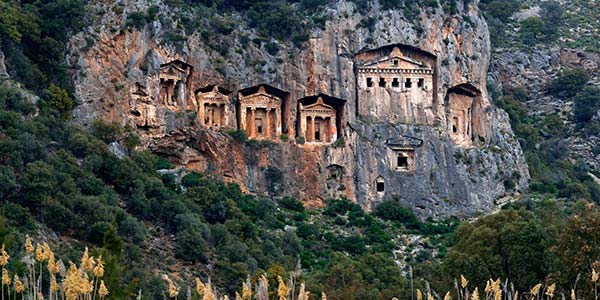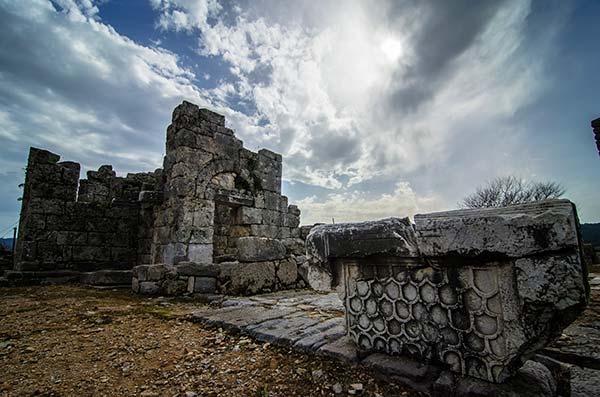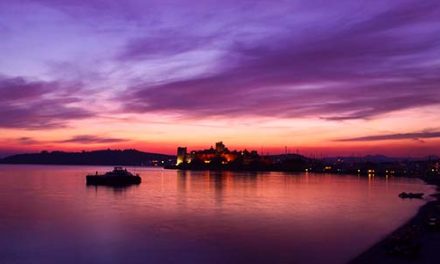The ancient city of Kaunos, which is on the UNESCO World Heritage Tentative List, takes its visitors on a journey through history with its rock tombs, a theater with a capacity of 5,000 people, a basilica, a Turkish bath, an agora and the Holy Temple of Demeter.

History of Kaunos
Kaunos, for the first time on British Rd. Discovered by Hoskyn. Hoskyn concluded that this region is the city of Kaunos, from the inscription “People and Assembly of Kaunos” on a written block he found during his visit in 1840. The most important feature of the ancient city is the rock tombs that stand erect even today. According to the Amasian geographer Strabo, there were shipyards in Kaunos and a port that could be shut down below the Acropolis (Castle and Walls, City center) (now Sülüklü Göl).
Over time, the ancient city of Kaunos passed under the rule of Persia, Egypt, Rhodes, Pergamum and the Roman Empire.
Kaunos, which was a commercially important port city in Antiquity, lost its port feature over time as the sea was filled with alluvium.
According to Herodotus, the father of history, the people of Caunos were from the indigenous people of Caria, but they considered themselves Cretans.
The one on the north side of the walls is from the Middle Ages. The long wall starts from the north of the harbor and extends to the steep cliff beyond Dalyan Village. The northern part of the wall was built during the Mausolos period. Those to the northwest are from the Hellenistic Period. The ones towards the harbor are from the Archaic Period.
The theater is at the foot of the acropolis. There are 33 rows of seats. One of the building remains to the west of the theater belongs to a basilica type church. Others belong to the Roman Bath and Temple.
Behind the structure, which is built in the form of an incomplete circle and has smooth columns, there is a podium raised by three steps. Here you can see the ruins of the temple. It is not known what the circular structure was.

Green-faced Caunos
It is known that Dalyan and its surroundings were in danger of malaria until the late 1940s. With the mosquito control carried out in these years, if not mosquitoes, malaria disease has been eradicated. This means that Kaunos has suffered from malaria throughout its history. Although they do not accept it, this malaria must be the reason why the people of Caunos are so ‘green-faced’ that they are called ‘sick’. We learn about this suffering and reluctance from a small story attributed to Stratonikos, one of the harp masters of the Hellenistic Age: When Stratonikos saw green-faced people walking on the streets of Kaunos, “people’s lives were equal to those of leaves.” he stated his thoughts. When the people of the city complained that they were ridiculed, his complaint this time replied: “…should I have been so arrogant by calling this city sick when there were corpses walking around,…” (Strabo XIV, 651.3.). .
Legend of Caunos (Byblis)
According to Herodotus, Kaunos also has a legendary story. Among the twin children of Miletos, the King of Caria, the boy’s name is Kaunos, and the girl’s is Byblis. Of the two brothers, Byblis falls in love with his brother Kaunos when he grows up. When Byblis’ father, who could not find a response from Kaunos, found out about the situation, he expelled Kaunos from the country and Kaunos founded today’s Kaunos Ancient City with the people he loved. Byblis, on the other hand, cannot bear this grief, he is exhausted from crying. It is said that the labyrinth-like canals of Dalyan consisting of fresh water are formed by the tears of Byblis.
Dalyan King Tombs
One of the structures you should see on your trip to Kaunos is the rock tombs on the big cliff next to the ancient city of Kaunos. The reason why the rock tombs, which were built for people of high status and an example of which is in Dalyan, were built so high was previously associated with being close to God. The rock tombs carved into the rocks are one of the most fascinating sights of Dalyan.
Although it is not known how the carving on the hard rocks was made, the result is one of Dalyan’s landmarks. The tombs were thought to be independent of the mountain and were set wide enough for people to walk around. It is estimated that the tomb on the far right of the rock tombs, which is a visiting point during Dalyan boat tours and you pass by, was left unfinished after the invasion of the Persians or Alexander the Great.

Getting to Kaunos:
You can reach Kaunos, which is right across Dalyan, in 3 ways.
The easy one is to go to the opposite shore by boat from the level of the king tombs. Here, the boats owned by the ladies of Dalyan are waiting and they are carrying passengers across the Dalyan Canal. If you choose this road, you can see the royal tombs up close at the crossroads. You can even climb the group on the left if the door is open. A 10-minute walk from the rock tombs will take you to the upper entrance of Kaunos.
The second way is to go to the archaeologists’ house by boat. From here, you can reach the upper entrance with a 5-minute walk.
The third way is to go by boat to the lower entrance pier of Kaunos, next to the big fish of Dalyan Fisheries Cooperative. There are boards showing the places to visit in Kaunos, a buffet where you can meet your needs, WC and cafeteria. If you get tired of walking, we recommend you to rest in the shade of the centuries-old olive trees that have taken root between the step blocks of the ancient theater and breathe the history.
Visiting Information:
April 15 / October 2
Summer Visiting Hours: 08:30 – 19:30
October 3 / April 14
Winter Visiting Hours: 08:30 – 17:30
Holiday Day: NO
Entry Fee: 12 TL
T.R. According to the 10th article of the directive on the procedures and principles to be applied at the entrance to the Museums and Archaeological Sites determined by the Ministry of Culture and Tourism;
Museums and archaeological sites are closed until 13:00 on the first day of religious holidays.
You can visit unlimitedly with Müzekart+ for a year.
Address : Dalyan
E-mail : muglabilgi@muglakulturturizm.gov.tr
muglainfo@muglakulturturizm.gov.tr
Phone : +90 (252) 214 12 61
+90 (252) 214 10 14
+90 (252) 214 31 27
+90 (252) 214 60 06
Click for Visiting Information Source





Trackbacks/Pingbacks